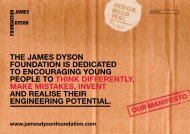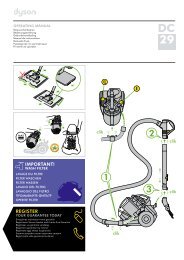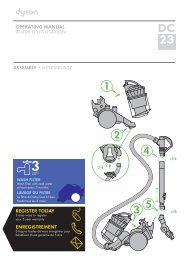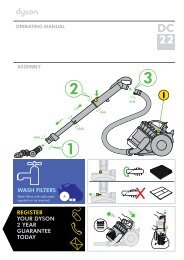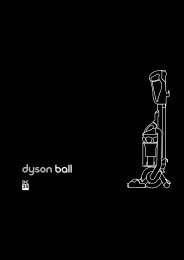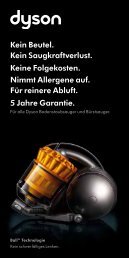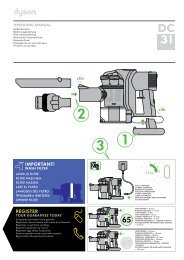DESIGN ICONS - Dyson.com
DESIGN ICONS - Dyson.com
DESIGN ICONS - Dyson.com
You also want an ePaper? Increase the reach of your titles
YUMPU automatically turns print PDFs into web optimized ePapers that Google loves.
Contemporary<br />
<strong>DESIGN</strong><br />
<strong>ICONS</strong>
Frankenstein<br />
Contemporary<br />
<strong>DESIGN</strong><br />
<strong>ICONS</strong><br />
selected by James <strong>Dyson</strong><br />
20 20
Contents<br />
Introduction<br />
Foreword<br />
<strong>Dyson</strong> Research, Design<br />
and Development centre<br />
Concorde<br />
Hovercraft<br />
Citroën DS<br />
DCO2 Clear<br />
Challenge of Materials Bridge<br />
Sony Walkman<br />
Moulton Bicycle<br />
MacLaren Buggy<br />
Gaggia Espresso Machine<br />
B306 Chaise Longue<br />
8<br />
10<br />
12<br />
14<br />
16<br />
18<br />
20<br />
22<br />
24<br />
26<br />
28<br />
30<br />
32<br />
Rotring Engineering Pencil<br />
Design Museum, London<br />
Geodesic Dome<br />
RB211 Engine<br />
John Hancock Center, Chicago<br />
Wink Chair<br />
Heron Parigi Drawing Board<br />
Art Museum, Denver<br />
Austin Morris Mini<br />
JCB Digger<br />
Eames Lounge Chair<br />
Toio Lamp<br />
A-POC, A Piece Of Cloth<br />
Picture Credits<br />
34<br />
36<br />
38<br />
40<br />
42<br />
44<br />
46<br />
48<br />
50<br />
52<br />
54<br />
56<br />
58<br />
60
“ For me, design is about<br />
how something works, not<br />
how it looks. It’s what’s<br />
inside that counts. ”<br />
James <strong>Dyson</strong>
James <strong>Dyson</strong><br />
Born in 1947, <strong>Dyson</strong> attended Gresham’s School in his home city of<br />
Norfolk, followed by the Byam Shaw School of Drawing and<br />
Painting and then the Royal College of Art, which are both in<br />
London. While training as a product designer at the RCA, he gained<br />
several <strong>com</strong>missions and his work won a number of awards.<br />
From 1970, he spent four years managing the marine division of<br />
Bath-based engineering <strong>com</strong>pany Rotork, before starting his own<br />
<strong>com</strong>pany. The revolutionary Ballbarrow was his major invention of<br />
this period, winning a Building Design Innovation award.<br />
James <strong>Dyson</strong> sold his shares in Ballbarrow in 1978 to fund the<br />
development of the dual cyclone vacuum cleaner. Over the next five<br />
years, he built more than 5,000 prototypes, before he succeeded<br />
with G-Force in 1983. The DCO1was launched in 1993 and quickly<br />
became the best-selling vacuum cleaner in the UK. <strong>Dyson</strong> products<br />
are now exported around the world and the <strong>com</strong>pany won a<br />
Queen’s Award for Innovation in 2003.<br />
Awarded the CBE in 1998, James <strong>Dyson</strong> became the first engineer<br />
to give the prestigious Dimbleby Lecture for the BBC in 2004.<br />
James <strong>Dyson</strong> was Chairman of the Design Museum for 5 years,<br />
has won numerous awards including Designer of the Decade,<br />
Entrepreneur of the year, and the European Design Prize. James<br />
sits on a number of design boards, including council member of the<br />
Royal College of Art, director of Imperial College, London, Museum<br />
fur Angewandte Kunst (MAK) Vienna, and Member of Industrial<br />
Design Society of America.<br />
8 9
Foreword<br />
“ I have not failed. I've just found 10,000 ways that won't work. ”<br />
Thomas A. Edison<br />
Some years ago, through pure frustration, I resolved to make a better<br />
wheelbarrow. And then a better vacuum cleaner. And then a<br />
better washing machine. My intention was to create products that<br />
served their purpose better than anything else available.<br />
In that respect, I wanted to follow the path of my hero, Isambard<br />
Kingdom Brunel. In 2004, BBC viewers voted Brunel the greatest<br />
Briton ever after Churchill, so I am not alone. Yet his profession –<br />
engineering - is not particularly highly regarded. Design used to<br />
mean bridges, railways, purpose. Personally, I don’t see the difference<br />
between designers and engineers. They are one.<br />
innovative suspension system and inimitable shape is inspired<br />
design and can stand shoulder to shoulder, or bumper to bumper,<br />
alongside cars designed today.<br />
For me, design is about how something works, not how it looks. It’s<br />
what’s inside that counts. The best designs <strong>com</strong>e from someone<br />
questioning everything. Designers, engineers look at the same<br />
things as everyone else. But they see something different. And<br />
they think what could be – and make it happen…..even if it takes<br />
5,127 prototypes to succeed.<br />
James <strong>Dyson</strong><br />
10<br />
Most people only consider how something was designed if it doesn’t<br />
work. Real design works. The best products evolve as part of a<br />
design process, in which the technology on the inside informs the<br />
way that they look on the outside. The success of <strong>com</strong>panies such<br />
as JCB and Rolls-Royce Aerospace illustrates the importance of<br />
keeping technology and innovation at the heart of design. For the<br />
same reason, the Citroen DS, with its many technological patents,<br />
11
12<br />
<strong>Dyson</strong> RDD centre<br />
1998 Chris Wilkinson Architects<br />
Up above, windows<br />
in a wavy<br />
roof allow light<br />
to penetrate<br />
deeply. More<br />
functional than<br />
a flat roof, it<br />
disperses rainwater<br />
through<br />
small pipes,<br />
which literally<br />
suck the water<br />
away. It can<br />
also be easily<br />
disassembled<br />
allowing new<br />
buildings to be<br />
bolted on.<br />
Too many working environments, whether they are<br />
offices or factories, are dull, uninspiring or downright<br />
ugly. They may be designed to be functional,<br />
but many fail even in that respect. Little wonder so<br />
many people hate work.<br />
James <strong>Dyson</strong> was determined to be different.<br />
Chris Wilkinson’s design for the <strong>Dyson</strong> Research,<br />
Design and Development Centre in Malmesbury,<br />
Wiltshire is intended to make the working<br />
environment inspiring. The building yells innovation and<br />
excitement. It says “great place to work”. Indeed, it is designed<br />
to attract high-calibre people,the best in their fields, and make<br />
them want to stay. A building can do as much towards creating<br />
a happy environment as the people it contains.<br />
Chris Wilkinson was asked to create a space that would reflect<br />
both <strong>Dyson</strong>'s creativity and the surrounding landscape. So dividers<br />
do not separate workspaces, keeping the interior flexible and,<br />
wherever possible, open plan. As in any <strong>com</strong>petitive business,<br />
there are secure areas, but they are not oppressive.<br />
The building reflects <strong>Dyson</strong>’s philosophy of cleanliness, freshness<br />
and efficiency delivered through robust systems
14<br />
Concorde<br />
1969 BAC/Sud<br />
The Soviet<br />
answer to the<br />
Concorde –<br />
the ill-fated<br />
Tupolev Tu 144<br />
– was dubbed<br />
“Concordski”<br />
by the ever<br />
imaginative<br />
British press.<br />
Fuel is<br />
pumped from<br />
one part of<br />
Concorde to<br />
another, maintaining<br />
the<br />
aircraft’s flight<br />
balance as the<br />
tanks empty.<br />
British prestige suffered plenty of blows during<br />
the early 1960s. Among them was the abrupt<br />
cancelling of the entire programme for developing<br />
supersonic <strong>com</strong>bat aircraft. One allied project did<br />
go ahead, however – and was to inject a big dose<br />
of pride into the national psyche.<br />
The BAC/Sud Concorde was revolutionary in<br />
many ways. It carried <strong>com</strong>mercial passengers<br />
at speeds much faster than sound (up to Mach 2,<br />
in fact). It boasted a stunningly beautiful<br />
double-delta wing formation with no need for<br />
a tail. And – perhaps most amazing of all –<br />
it was developed simultaneously in two sites,<br />
Toulouse in France and Filton in the UK.<br />
Both prototypes embarked upon their maiden<br />
flights on the same day in 1969, provoking much<br />
public euphoria. Concorde’s <strong>com</strong>mercial success<br />
was to be limited by high running costs, but its<br />
slender, elegant shape (ac<strong>com</strong>panied by the harsh<br />
roar of its afterburners) soon became a familiar and<br />
enchanting sight in British skies.
16<br />
Hovercraft<br />
1959 Christopher Cockerell<br />
In Canada,<br />
specially<br />
adapted<br />
hovercraft are<br />
used to break<br />
ice on<br />
waterways.<br />
A hovercraft<br />
can be steered<br />
by rudders,<br />
propellers or<br />
small doors in<br />
the skirt called<br />
“puff ports”.<br />
Hovercraft<br />
can’t go<br />
up-hill.<br />
The main obstacle to speedy travel – on water or<br />
land – is drag. One neat answer to this problem of<br />
friction, first researched in the 1870s, was to float<br />
the vessel concerned on a cushion of <strong>com</strong>pressed<br />
air. Thus, it does not touch the water, but hovers<br />
above it.<br />
No practical breakthrough came, however,<br />
until the 1950s, when the British scientist<br />
Christopher Cockerell devised the first<br />
successful Air Cushion Vehicle or “hovercraft”.<br />
His SRN-1 created a sensation when it was<br />
launched in 1959. Gas turbine engines powered<br />
the lift fans, which sucked in air and forced it down<br />
into a space beneath the vessel. This air cushion<br />
was contained within a flexible rubberised skirt.<br />
Driven forward by aircraft propellers, the hovercraft<br />
was highly manoeuvrable and could reach speeds<br />
of over 100 km/h (62 mph). A larger model, capable<br />
of carrying over 400 passengers and 60 vehicles,<br />
soon established itself as an alternative (and less<br />
nauseating) ferry across the English Channel.
18<br />
Citroën DS<br />
1955 Citroën<br />
The Citroën DS<br />
needed no<br />
conventional<br />
jack when a<br />
wheel had to<br />
be changed.<br />
The pneumatic<br />
suspension did<br />
the job.<br />
One<br />
unfortunate<br />
side-effect of<br />
the DS’s rolling<br />
suspension<br />
for many<br />
passengers<br />
was a kind of<br />
sea-sickness.<br />
The launch of the Citroën DS19 staggered<br />
the motoring world in 1955. It was, simply,<br />
the most technically advanced saloon car ever<br />
seen. To enhance the effect, Citroën christened<br />
it the “Goddess” or “Déesse” – hence DS.<br />
For a start, the DS looked extraordinary. At the<br />
front, the nose sloped to a point. Where was the<br />
air intake? At the back, the bodywork curved<br />
down to the bumpers and enclosed the rear<br />
wheels. The steering wheel had a single spoke.<br />
Then there was the suspension, each wheel<br />
being supported independently. The system was<br />
self-levelling, with pneumatic struts riding in oil,<br />
fed from a central reservoir. When the engine was<br />
started, the suspension would gently pump itself<br />
up to the correct height, no matter what weight<br />
was being carried.<br />
Other marvels included power-assisted steering,<br />
power brakes operated by a tiny button on the<br />
floor, and an automatic pneumatic clutch. It was<br />
a futuristic car, which demanded futuristic drivers,<br />
and proved quite a handful for lesser mortals.
20<br />
DCO2 Clear<br />
1997, James <strong>Dyson</strong><br />
Within 18<br />
months of<br />
launching<br />
<strong>Dyson</strong> was the<br />
best selling<br />
vacuum cleaner<br />
in the UK.<br />
In 1998 Tony<br />
Blair<br />
announced<br />
that the DC02<br />
cleaner had<br />
been chosen<br />
as one of the<br />
UK’s first<br />
“Millennium”<br />
products<br />
<strong>Dyson</strong>’s pioneering bagless vacuum cleaner, the<br />
DCO1, changed the face of the market on its<br />
launch in 1993. After more than 5,000 prototypes<br />
and fourteen years of development, the Dual<br />
Cyclone – or DC – was the first vacuum not to lose<br />
suction. With no paper bag to clog and restrict airflow,<br />
it worked properly !<br />
For the first time, customers could see how the<br />
vacuum cleaning process actually worked. With its<br />
patented clear bin the DCO1 captured the public’s<br />
imagination.<br />
<strong>Dyson</strong>’s DCO2 Clear went further. Launched in<br />
1997, it pioneered the use of translucent plastic in<br />
a household product - even before the Apple iMac.<br />
Everyone could see, learn and enjoy the engineering<br />
behind the cleaning. Tinted green and blue, the<br />
yellow inner <strong>com</strong>ponents allow the eye to follow the<br />
<strong>com</strong>plete airflow process as two cyclones separate<br />
air and dirt by centrifugal force.
22<br />
Challenge of Materials Bridge<br />
1995 Chris Wilkinson Architects<br />
Among other<br />
Wilkinsondesigned<br />
bridges are the<br />
Hulme Arch in<br />
Manchester,<br />
The Butterfly<br />
Bridge in<br />
Bedford<br />
and the<br />
South Quay<br />
Footbridge at<br />
Canary Wharf,<br />
London.<br />
The most extraordinary addition to London’s<br />
Science Museum in the 1990s has been the<br />
Challenge of Materials Gallery.<br />
A series of stunning architectural conceits creates<br />
a framework which allows the visitor to explore<br />
the infinite possibilities of material science.<br />
At the heart of the gallery is Chris Wilkinson’s<br />
magical and intriguing bridge. It spans the atrium,<br />
floating at mezzanine level across the internal<br />
space and providing a visual focus for the other<br />
exhibits. It also demonstrates how materials can<br />
be pushed to surprising limits.<br />
The design of the bridge is simple in the extreme.<br />
The deck is formed by over 800 glass planks,<br />
suspended from a network of ultra-thin stainless<br />
steel wires. Channelled through stress gauges,<br />
these wires activate acoustic and lighting systems<br />
devised by eccentric sound artist Ron Geesin.
24<br />
Sony Walkman<br />
1979 Sony Corporation<br />
Sony had to<br />
impose the<br />
worldwide<br />
name<br />
“Walkman”<br />
after its<br />
American business<br />
insisted<br />
that the word<br />
wasn’t proper<br />
English and<br />
called their version<br />
the<br />
Soundabout.<br />
In Australia, it<br />
was known as<br />
the Freestyle.<br />
The name<br />
“Sony” is<br />
derived from<br />
the Latin sonus<br />
meaning<br />
sound.<br />
Originally, this<br />
Japanese corporation<br />
had<br />
the much more<br />
cumbersome<br />
title of the<br />
Tokyo Tsushin<br />
Kogyo<br />
Company.<br />
Like Sellotape, Post-IT and JCB, Walkman has<br />
achieved generic term status. Whatever the manufacturer<br />
of one’s small, portable stereo cassette<br />
player, you will know it as a Walkman, pure and<br />
simple. The CD version, the Discman, didn’t manage<br />
the generic accolade, where consumers stick<br />
doggedly to the more <strong>com</strong>mon term, CD Walkman.<br />
That in itself reinforces the Walkman’s iconic<br />
nature.<br />
It wasn’t long after the 1979 launch that the basic<br />
Walkman began to appear in a variety of tailored<br />
guises, not least for swimmers. Going underwater?<br />
No need to leave your music behind when you can<br />
bathe with a water-resistant Walkman.<br />
The casing is designed for active outdoor use, with<br />
waterproof seals that help keep water out.<br />
Thought has been given on how to keep the device<br />
securely strapped to the body during vigorous<br />
activity. In addition to technical genius, Sony is a<br />
marketing colossus: spotting specific market segments<br />
and crafting products that appeal.
26<br />
Moulton Bicycle<br />
1958 Alex Moulton<br />
At 51 mph, the<br />
Moulton holds<br />
the world bicycle<br />
speed<br />
record in a<br />
conventional<br />
riding position.<br />
Moulton offers<br />
a single frame<br />
size that fits all<br />
riders with no<br />
annoying top<br />
crossbar.<br />
Anyone who has ridden a bike for more than a couple<br />
of hours will understand the meaning of the<br />
phrase “saddle-sore”. Horse not needed.<br />
Alex Moulton has spent almost 50 years continuously<br />
developing the perfect, hand-built bike.<br />
Having built suspension systems for cars (including<br />
the revolutionary Mini), Alex created a smallwheeled<br />
bike that was faster, more <strong>com</strong>pact and<br />
hugely more <strong>com</strong>fortable than its conventional<br />
cousins.<br />
Small wheels define Moulton bikes. With only half<br />
the rotating mass of standard wheels and highpressure<br />
tyres, aerodynamic drag is lower, riders<br />
can pedal faster with less effort, and the whole bike<br />
is sturdier.<br />
Moulton’s folding bike is a dream, and not just<br />
because it is <strong>com</strong>pact and portable. The structure of<br />
the frame – a lattice of small diameter tubes – is far<br />
stiffer than a conventional diamond frame. It’s made<br />
from the same type of stainless steel tubing found<br />
on jet fighters for transmission of hydraulic fluids.
28<br />
MacLaren buggy<br />
1965 Owen MacLaren<br />
MacLaren’s<br />
first buggy<br />
weighed less<br />
than three kilograms.<br />
Modern<br />
MacLarens fold<br />
in five seconds,<br />
so parents can<br />
tuck a child<br />
under one arm<br />
and still fold<br />
away the<br />
buggy<br />
It’s rocket science! If you think baby deserves best,<br />
buy a buggy designed by a Spitfire pilot and aeronautical<br />
engineer.<br />
Owen MacLaren helped design the Spitfire’s<br />
undercarriage, so he knew a thing or two about<br />
lightweight, rigid, load-bearing structures. In 1965,<br />
not very impressed with existing products, he<br />
applied his knowledge to the important personal<br />
challenge of conveying his grandchild around.<br />
Until then, parents were stuck with perambulators<br />
– prams – unwieldy carriages of unattractive proportions<br />
with huge hoods that hid the child from<br />
the outside world.<br />
The MacLaren Baby Buggy was far more practical<br />
for both transporting the infant and for storage.<br />
Employing lightweight materials such as tubular<br />
aluminium, MacLaren’s structure could carry a sizable<br />
toddler and still fold away into a space not<br />
much bigger than that of a rolled umbrella. Its<br />
three-dimensional folding mechanism was umbrella-like<br />
too. In fact, it is sometimes referred to as the<br />
“umbrella stroller”.
30<br />
Gaggia Espresso Machine<br />
1938 Achille Gaggia<br />
Cliff Richard’s<br />
early film<br />
Expresso Bongo<br />
(1960) was one<br />
of many at the<br />
time centred<br />
on coffee bar<br />
culture –<br />
in this case,<br />
London’s Soho.<br />
The first Gaggia<br />
machines were<br />
imported into<br />
the UK by an<br />
emigrant Italian<br />
dental mechanic<br />
who was<br />
appalled at<br />
the quality of<br />
English coffee.<br />
Few inventions have spawned an entire subculture.<br />
One such rarity is the espresso coffee machine<br />
developed by an indefatigable Italian engineer,<br />
Achille Gaggia, in the 1930s. In the post-war<br />
years, these gloriously dramatic chrome and gold<br />
constructions sold throughout Europe as fast as<br />
the Milan factory could make them.<br />
The secret of Gaggia’s success lay in the sprung<br />
piston system, by which hot water was forced at<br />
high pressure through finely ground coffee beans<br />
held in a filter. This did away with the traditional<br />
need for steam, which produced a much inferior<br />
brew.<br />
Modern coffee bars sprang up at railway<br />
stations and on street corners, catering for the new<br />
custom of taking a nip of concentrated black<br />
coffee at regular intervals throughout the day.<br />
These bars became social centres, especially<br />
for the young. Dozens of variations were dreamed<br />
up – “cappuccino”, “ristretto” (extra strong) and<br />
“corretto” (with a shot of grappa).
32<br />
B306 Chaise Longue<br />
1928-29 Le Corbusier/Pierre Jeanneret/Charlotte Perriand<br />
Le Corbusier<br />
is regarded<br />
primarily as an<br />
architect, yet<br />
his furniture<br />
design<br />
partnership<br />
with Charlotte<br />
Perriand was<br />
long-lived and<br />
highly<br />
influential.<br />
The<br />
upholstered<br />
parts of the<br />
chaise are<br />
available in<br />
hairy skin,<br />
leather or<br />
canvas.<br />
Charles Edouard Jeanneret, otherwise Le<br />
Corbusier, famously stated that a house was<br />
a machine for living in. He extended this to<br />
cover the furniture inside as well, and was later<br />
to describe his celebrated chaise longue as<br />
“a real machine for rest”.<br />
History has proved him right, both technically<br />
and artistically. The B306 is still re<strong>com</strong>mended<br />
by orthopedists today as ideal for back sufferers.<br />
It does not try to imitate the shape of the body,<br />
yet supports the entire back while placing the<br />
legs at the correct angle to relieve stress.<br />
The chaise longue is just as pleasing aesthetically.<br />
It sits inside another metal frame, which enables<br />
it to slide in an arc and thus move the sitter in<br />
one smooth continuum from upright to supine.<br />
The simple, fluid outlines testify to Le Corbusier’s<br />
determination to link artistic theory with practice.
34<br />
Rotring Engineering Pencil<br />
1977 Rotring Group<br />
The invention<br />
of the Rotring<br />
engineering<br />
pencil posed a<br />
serious threat<br />
to the pencilsharpening<br />
business.<br />
Rotring’s ditty<br />
(above)<br />
advertising the<br />
four-colour<br />
ballpoint<br />
translates as<br />
“Saucy chicks,<br />
– bright tips”.<br />
Chunky, unpretentious and utterly dependable,<br />
Rotring engineering pencils and pens have no<br />
serious rival. The simplicity of the pencil’s design –<br />
plain aluminium, hexagonal in section – somehow<br />
exudes quiet authority. And at its top, the thin<br />
red ring (in German, “rotor ring”) subtly proclaims<br />
its maker.<br />
It was in 1928 that Wilhelm Riepe developed the<br />
world’s first nibless fountain pen. The innovation<br />
was taken a step further by Wilhelm’s son, who<br />
launched the radiograph – the original technical<br />
pen – in 1953.<br />
The firm became Rotring a decade later and<br />
has since grown into a massive worldwide<br />
group of <strong>com</strong>panies. Its products now include<br />
everything, from capillary ink cartridges and<br />
<strong>com</strong>puter-controlled lettering machines to<br />
artists’ oils and colour cosmetics. But, to a<br />
host of planners, designers, inventors and<br />
dreamers, the engineering pencil remains its<br />
finest contribution to the twentieth century.
36<br />
Design Museum London<br />
1987-89 Conran/Roche<br />
The museum<br />
also houses<br />
a resource<br />
centre, to<br />
service the<br />
design<br />
industry,<br />
as well as<br />
Conran’s<br />
celebrated<br />
Blueprint Café.<br />
Terence Conran and Stephen Bayley established<br />
the Design Museum to explain, improve and<br />
raise awareness of design standards in the UK.<br />
They believed that consumer goods deserved a<br />
focal point, where their function, appearance and<br />
marketing could be examined and explained.<br />
The pair found a disused warehouse overlooking<br />
the River Thames near Butler’s Wharf. It was too<br />
costly to renovate <strong>com</strong>pletely, so they decided to<br />
demolish and rebuild a major portion. The result<br />
was a ‘new’ 1930s building, an assemblage of<br />
rectangles with a subtly layered frontage.<br />
The coolness of the exterior (the original brick<br />
having been covered in white stucco) was<br />
echoed inside. The galleries on the top two<br />
floors are flooded with natural light, bringing<br />
to life the neutral tones of oak and marble floors<br />
and white walls. The sight of the Thames running<br />
smoothly below adds to the general calmness.<br />
No wonder one critic praised the Museum’s<br />
‘atmosphere of quiet decorum’.
38<br />
Geodesic Dome<br />
1954 R. Buckminster Fuller<br />
Within 30 years<br />
of Fuller’<br />
patenting his<br />
geodesic<br />
dome, more<br />
than 50,000<br />
structures had<br />
been built.<br />
The most well<br />
known dome is<br />
Disney’s Epcot<br />
Centre in<br />
Florida, often<br />
mistaken for a<br />
giant golf ball!<br />
Richard Buckminster Fuller was a brilliant<br />
and prophetic engineer, who aimed his many<br />
inventions unequivocally at the betterment of<br />
humanity. Among these were a rechargeable<br />
electric car, a vehicle which could move in any<br />
direction and an all-metal house in kit form.<br />
Fuller was intense in his belief that people could<br />
control large parts of their environment without<br />
being divorced from nature. To that end he<br />
developed what he called the ‘geodesic’ dome.<br />
This was a large, lightweight enclosure which<br />
<strong>com</strong>bined great strength with a minimal structure.<br />
The surface of the dome is honey<strong>com</strong>bed<br />
into triangular pieces by a latticework of rods.<br />
This highly efficient framework can easily support<br />
a weather-proof covering. Alternatively, the dome<br />
can be formed of solid panels. The geometry of<br />
the structure makes it perfectly rigid even when<br />
built of a weak material such as cardboard.
40<br />
RB211 Engine<br />
1968 Rolls-Royce<br />
After the 1971<br />
bankruptcy,<br />
Rolls-Royce<br />
was re-formed<br />
as two<br />
separate<br />
<strong>com</strong>panies –<br />
one to build<br />
jet engines,<br />
the other to<br />
produce<br />
automobile<br />
and diesel<br />
engines.<br />
RB stands for Rolls-Royce Barnoldswick.<br />
This division of the legendary <strong>com</strong>pany was<br />
opened in an old tank engine factory in<br />
Nottinghamshire in 1943, and it was here<br />
that engineers created many of the most<br />
powerful aero engines in the world.<br />
Among these was the RB211, introduced with<br />
a flourish in 1968. This pioneering engine, with<br />
40,600lb of thrust, was ordered by Lockheed<br />
to power its brand new Tristar airbus. The most<br />
astonishing quality of the RB211 was its light<br />
weight, thanks to fan blades made of carbon fibre.<br />
The triumph, alas, soon turned to disaster.<br />
The revolutionary new carbon material proved<br />
too weak for the stresses of wear, and had to be<br />
replaced with heavier titanium. Rolls-Royce itself<br />
went bankrupt in 1971. But the RB211 was saved.<br />
Completely redesigned, it did indeed launch the<br />
popular Tristar. And in 1981 Boeing selected an<br />
improved model to power the outstandingly<br />
efficient 757 airliner – the first time Boeing had ever<br />
introduced an aircraft with a non-US power plant.
42<br />
John Hancock Center Chicago<br />
1968-70 Bruce Graham<br />
The sky lobby –<br />
between<br />
floors 44-45 –<br />
is where<br />
everyone<br />
changes<br />
elevators. You<br />
can stop here<br />
to eat, shop or<br />
even take a<br />
dip in the<br />
swimming<br />
pool.<br />
As American skyscrapers grew taller in the<br />
post-war era, materials and design solutions were<br />
stretched to the limit. Existing structural systems<br />
had to be revised. Added strength and resilience<br />
had to be found from somewhere.<br />
The John Hancock Center in Chicago presented<br />
a clear answer to the problem. The building’s<br />
designer Bruce Graham described it succinctly<br />
as ‘a diagonally braced tube’. The X-shaped<br />
bracing on the exterior was a visible expression of<br />
its structural efficiency, with the walls bearing most<br />
of the vertical load, and also coping with the lateral<br />
forces of wind. A secondary system of floors and<br />
window panels added sturdiness internally.<br />
The Center is also visually breathtaking, its tapered<br />
steel form making a dramatic silhouette against the<br />
Chicago skyline. This elegance is heightened by<br />
the understated dark colouring of the exterior.
44<br />
Wink Chair<br />
1980 Toshiyuki Kita<br />
What is an ‘animated’ chair? The idea of an<br />
assemblage of steel, dacron and foam plastic<br />
<strong>com</strong>ing to life is perverse. And yet the Wink<br />
chair, with its Mickey-Mouse-ear armrests,<br />
its rounded contours and its jolly colours,<br />
has an animal-like charm quite unlike most<br />
other modern furniture. One critic likened it<br />
to a gigantic friendly insect.<br />
The Wink moves, too. It can be flexed and<br />
bent to many different positions, from upright<br />
armchair to lounger. This neatly encapsulates<br />
the Japanese custom of sitting on the floor<br />
whilst offering the Western visitor the <strong>com</strong>fort<br />
of a traditional backed chair.<br />
Indeed, the Wink is the embodiment of<br />
Toshiyuki’s determination to assert his<br />
cultural identity. His work, which includes<br />
paper lampshades and lacquer tableware,<br />
has been instrumental in the recent revival<br />
of native Japanese arts. Yet his experiences<br />
of the West have led him, he writes, ‘to design<br />
objects which take into account the values of<br />
both worlds’.
46<br />
Heron Parigi Drawing Board<br />
1964 Paolo Parigi<br />
“Metal is not<br />
cold. Metal<br />
is beauty,<br />
severe<br />
and un<strong>com</strong>promising.<br />
It seeks no<br />
accord from<br />
the world<br />
which<br />
surrounds it.<br />
It is sublime,<br />
of a harshness<br />
that needs no<br />
sculpting.”<br />
Paolo Parigi<br />
Born near Florence in Italy in 1936, Paolo<br />
Parigi found himself learning his trade at<br />
the epicentre of post-war innovation in<br />
industrial design. At twenty-eight, he unveiled<br />
his first mass-produced project, the ‘Heron’<br />
drawing table, so-called because of its long<br />
legs and expectant attitude.<br />
It was an immediate success, and inspired<br />
in turn the <strong>com</strong>pany name, Heron Parigi.<br />
As partner and design director, Parigi has<br />
pioneered many ground-breaking products<br />
including some astonishing perforated<br />
metal benches and office chairs.<br />
The great virtues of his group’s designs<br />
lie in their apparent simplicity, their use of<br />
the minimum of parts and their pride in fine<br />
workmanship. These qualities can be seen<br />
to best effect in their vast range of drawing<br />
boards and tables, with their robust<br />
mechanisms and graceful efficiency.
48<br />
Art Museum Denver<br />
2003 Daniel Libeskind<br />
The building<br />
will form a<br />
“connected<br />
gateway”<br />
between<br />
downtown<br />
Denver and the<br />
burgeoning<br />
Golden<br />
Triangle area<br />
south of the<br />
museum.<br />
The new<br />
146,000<br />
square foot<br />
building will<br />
consist of geometric<br />
shards,<br />
flaring out like<br />
flower petals,<br />
built of glass,<br />
titanium and<br />
Colorado<br />
granite.<br />
A sharply<br />
angled<br />
cantilevered<br />
section will jut<br />
across the<br />
street toward<br />
the existing<br />
museum.<br />
Founded in 1893, the Denver Art Museum has the<br />
largest and most <strong>com</strong>prehensive collection of world<br />
art between Kansas City and the West Coast.<br />
The present building is itself as much a work of art<br />
as the objects it contains. The 28-sided, two-towered<br />
building, designed by Italian Gio Ponti in<br />
collaboration with James Sudler Associates of<br />
Denver, has seven floors of gallery space, stacked<br />
vertically to enable visitors to reach desired exhibits<br />
quickly by elevator. The exterior is covered with<br />
more than one million faceted, shimmering grey tiles<br />
specially designed by Dow Corning.<br />
In 2006, the Denver Art Museum will nearly double<br />
in size and boast one of the country’s most unique<br />
structures. Construction on an extraordinary new<br />
building designed by renowned architect Daniel<br />
Libeskind began in July 2003 and, when finished,<br />
will include permanent gallery space, special exhibition<br />
venues, a restaurant and a rooftop sculpture<br />
garden with spectacular mountain views.
50<br />
Austin Morris Mini<br />
1959 Alex Issigonis<br />
The Mini<br />
achieved its<br />
apotheosis<br />
with starring<br />
roles in<br />
60’s heist<br />
movies, The<br />
Italian Job<br />
(1969) and The<br />
Thomas Crown<br />
Affair (1968).<br />
Lawrence, the<br />
unfortunate<br />
husband of<br />
Beverly, in<br />
Abigail’s Party<br />
(1977),<br />
upgraded his<br />
Mini every year.<br />
One major<br />
stimulus<br />
for the<br />
creation<br />
of the<br />
economical<br />
Mini was the<br />
Suez Crisis of<br />
1956, which<br />
had led to<br />
petrol<br />
rationing.<br />
It began life as the BMC 850 and became the<br />
Austin Seven – the fifth car to bear that proud<br />
name. But it achieved legendary, almost totemic,<br />
status as the Mini, the most successful small car<br />
ever made. Sir Alex Issigonis had already designed<br />
one classic ‘<strong>com</strong>pact’, the Morris Minor, when<br />
he became BMC’s chief engineer in 1951.<br />
Soon he landed an even more challenging brief:<br />
to create a car which was small, fuel efficient and<br />
revolutionary in shape.<br />
The result was an astonishing landmark in<br />
automobile design, launched in 1959. With its<br />
engine set transversely and its gearbox nestling<br />
down in the sump, the new car was less than ten<br />
feet long. Yet it could easily carry four people and,<br />
thanks to small wheels and independent rubber<br />
suspension, it gave them a <strong>com</strong>fortable ride.<br />
Above all, the Mini was perfectly suited to the<br />
spirit of the times. Cheeky, unconventional and<br />
nippy (with excellent road-holding qualities,<br />
thanks to front-wheel drive), it was embraced as<br />
a chic symbol of the Swinging Sixties. With over<br />
six million sold, it has never gone out of fashion.
52<br />
JCB Digger<br />
1953 Joseph Bamford<br />
Bamford<br />
insisted that all<br />
his diggers<br />
were fitted with<br />
electric kettles.<br />
That way, the<br />
operator<br />
wouldn’t have<br />
to leave the<br />
<strong>com</strong>fort of his<br />
cab for a<br />
tea break.<br />
Before 1953 no-one had ever dug a ditch without<br />
a hand shovel. Then came Joe Bamford’s Mark I<br />
Hydraulic Excavator. It fitted on a standard Fordson<br />
tractor, could swivel a full 180 degrees and dig up<br />
to 45 cubic yards per hour. Above all, it made use<br />
of the incredible force which could be generated<br />
by hydraulic power.<br />
Over the next half century, JCBs played a major<br />
part in transforming the face of Britain – and<br />
the rest of the world. They sprouted bulldozer<br />
blades, backhoe buckets and crawler tracks.<br />
They became a permanent fixture on building<br />
and motorway sites, farms and quarries.<br />
“JCB” even gained the rare distinction of be<strong>com</strong>ing<br />
a generic word, a shorthand description for all<br />
excavators. Indeed, it now has its own proud<br />
entry in the Oxford English Dictionary.<br />
Bamford’s secret for success? ‘I always count<br />
the number of parts: parts are money. Better to<br />
keep it simple.’
54<br />
Eames Lounge Chair<br />
1956 Charles and Ray Eames<br />
Charles and<br />
Ray Eames<br />
were also<br />
experimental<br />
filmmakers,<br />
and featured<br />
their chair in an<br />
animated<br />
short. The title,<br />
naturally, was<br />
Eames Lounge<br />
Chair.<br />
One <strong>com</strong>mon<br />
misconception<br />
is that this was<br />
the chair<br />
designed for<br />
film director,<br />
Billy Wilder;<br />
that was the<br />
Eames chaise<br />
longue.<br />
“The warm receptive look of a well-used first<br />
baseman’s mitt.” This was the homely aim of<br />
Charles and Ray Eames when they created their<br />
Lounge Chair – and a homely object it has be<strong>com</strong>e,<br />
reproduced in a thousand guises all over the world.<br />
Derided by some as too conventional, and even<br />
too ugly, it is still a bestseller.<br />
In the 1950s, the Eames design partnership<br />
had accepted the challenge to design a modern<br />
American equivalent of the <strong>com</strong>fortable leather<br />
armchair beloved of English gentleman’s clubs.<br />
The result had to be culturally acceptable to a<br />
wide range of people.<br />
The chair’s basic framework was of three pieces<br />
of plywood, moulded in no more than two planes.<br />
This was covered in rosewood veneer and button<br />
black leather upholstery, stuffed with down, feather<br />
and foam. The whole rotated on an ingenious<br />
‘spider’ mechanism.
56<br />
Toio Lamp<br />
1962 Achille and Pier Gia<strong>com</strong>o Castiglioni<br />
The floor lamps<br />
in Castiglioni’s<br />
oeuvre are<br />
among the<br />
most beautiful<br />
and simple of<br />
his designs.<br />
His Toio lamp,<br />
and the<br />
Parentesi,<br />
a lamp<br />
suspended<br />
between floor<br />
and ceiling, are<br />
featured in the<br />
Museum of<br />
Modern Art’s<br />
collection in<br />
New York.<br />
With his brother Pier Gia<strong>com</strong>o, Achille Castiglioni<br />
emerged as a major driving force behind modern<br />
Italian design after the Second World War.<br />
Together they re-thought form, function and<br />
manufacturing techniques, and produced work<br />
of apparently effortless grace and practicality.<br />
For many of Castiglioni’s most enduring designs,<br />
he made use of many ‘off-the-shelf’ items,<br />
employing ready-made technology in fresh and<br />
often surprising ways. A tractor seat was fixed on<br />
a steel support to create a chair. The business end<br />
of the Toio floor lamp was simply a car headlamp.<br />
The headlamp, directed upwards, was mounted<br />
on an adjustable-height brass stem which was<br />
nickel-plated and polished. The chunky rectangular<br />
base was of enamelled steel. The novelty, as<br />
Castiglioni pointed out, lay not in the way the<br />
lamp looked but in the way it was put together.
58<br />
A-POC – a piece of cloth<br />
1989 Issey Miyake<br />
Over-length<br />
sweaters,<br />
dresses off the<br />
roll - “A-POC”<br />
is based upon<br />
Issey Miyake’s<br />
first design<br />
concept, a<br />
piece of cloth.<br />
It is a new and<br />
unique suggestion<br />
for<br />
everyday life,<br />
which goes far<br />
beyond the<br />
boundaries of<br />
fashion.<br />
It is made using an industrial knitting or weaving<br />
machine programmed by a <strong>com</strong>puter. This<br />
process creates continuous tubes of fabric within<br />
which lie both shape and pattern. The customer<br />
cuts sleeves and skirts exactly to the desired<br />
length. It is an idea that totally overthrows the<br />
existing standards for making clothes.<br />
“A-POC” is made in a sequence in which thread literally<br />
goes into a machine and re-emerges as a<br />
piece of clothing, an accessory, or even a chair.<br />
This interactive new method not only reduces leftover<br />
fabric but also permits the wearers to participate<br />
in the final step of the design of their clothing:<br />
they determine the final shape of the product.<br />
Mass production and custom-made clothing,<br />
seemingly opposing ideas, be<strong>com</strong>e <strong>com</strong>patible<br />
through the wizardry of technology and the fire<br />
of imagination.
60<br />
Acknowledgments<br />
Thanks are due to all of the individuals, <strong>com</strong>panies and organisations who helped<br />
towards the production of this book. Many provided material and information that was<br />
greatly appreciated.<br />
Picture Credits<br />
Every possible effort has been made to attribute all photographic credits as<br />
accurately as possible. In the instance of any mistakes or omissions, the<br />
publisher would like to offer their apologies and ask that misrepresented<br />
parties bring any such errors to our attention.<br />
12 © <strong>Dyson</strong><br />
15 © Jeremy Flack/Aviation Photographs International<br />
17 © Hovercraft Museum Trust (http://www.hovercraft-museum.org)<br />
18 & 19 © Citroën<br />
21 © <strong>Dyson</strong><br />
22 & 23 © James Morris / Courtesy of Chris Wilkinson Architects Limited.<br />
Project consultants: Whitby Bird & Partners; Hubbard Architectural Metalwork<br />
Limited; Ron Geesin<br />
25 © Sony<br />
27 © Alex Moulton bicycles<br />
29 © McLaren buggy<br />
31 © Gaggia (with thanks to Justin Stockwell, Chevron Foods Limited)<br />
32 & 33 Courtesy of Cassina USA<br />
34 & 35 © Rotring / Courtesy of Sanford<br />
36 & 37 © Jefferson Smith / Courtesy of Design Museum<br />
39 © Richard Bryant / Courtesy of Arcaid<br />
40 & 41 © Rolls-Royce plc<br />
42 & 43 © Ezra Stoller/Esto/Arcaid / Courtesy of Arcaid<br />
44 & 45 Courtesy of Cassina USA<br />
46 & 47 © Heron Parigi<br />
48 © Denver Art Museum<br />
51 © Hulton Getty<br />
52 & 53 © JCB<br />
55 © Eames Office (http://www.eamesoffice.<strong>com</strong>)<br />
56 Courtesy of Flos<br />
58 © Issey Miyake<br />
Front cover: © Heron Parigi<br />
Back cover left: © <strong>Dyson</strong><br />
Back cover middle: © JCB<br />
Back cover right: Courtesy of Flos<br />
61
First published in 1999 by Absolute Press,<br />
Icons selected by James <strong>Dyson</strong><br />
Text by Andrew Langley/Plain Text


